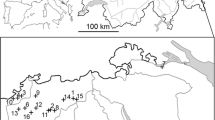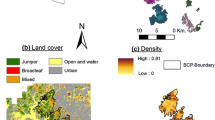Summary
Spring territories of 17 adult capercaillie (Tetrao urogallus L.) cocks were 10–79 ha in extent; they varied inversely in size with the relative proportion of mature forest within them. The number of resident cocks at leks increased with the amount of mature forest within a 1 km radius of each lek center. Leks in two areas (n=46) were regularly spaced with mean distances to nearest neighbors of 1.98 and 2.07 km, corresponding to the territorial space occupied by adult cocks of adjoining leks. In one area with intensive logging, interlek distance increased with decreasing amounts of mature forest between them. Spring home ranges of 18 adult females averaged 51.3 ha±8.2 SE. The spatial relationships did not fit recent models of interlek spacing based on female spacing behavior. Instead, the results suggested that spacing of leks may be related to the territorial requirements of males.
Similar content being viewed by others

References
Abrahamsen J, Jakobsen NK, Dahl E, Kalliola R, Wilborg L, Pāhlson L (1977) Naturgeografisk regioninndelning av Norden. Nordiska utredninger B 1977:34, Stockholm
Angelstam P (1983) Population dynamics of tetraonids, especially the black grouse, Tetrao tetrix L., in boreal forest. PhD thesis, Uppsala University, Uppsala, Sweden
Angelstam P, Jaarola M, Nordh N-E (1985) Are female black grouse Tetrao tetrix territorial? Ornis Fenn 62:124–129
Ballard WP, Robel RJ (1974) Reproductive importance of dominant male greater prairie chickens. Auk 91:75–86
Bendell JF, Elliott PW (1966) Habitat selection in blue grouse. Condor 68:431–446
Boag DA (1976) Influence of changing grouse density and forest attributes on the occupancy of a series of potential territories by male ruffed grouse. Can J Zool 54:1727–1736
Bradbury JW (1977) Lek mating behavior in the hammerheaded bat. Z Tierpsychol 45:225–255
Bradbury JW (1981) The evolution of leks. In: Alexander RD, Tinkle DW (eds) Natural selection and social behavior. Chiron, New York, pp 138–169
Bradbury JW, Gibson R (1983) Leks and mate choice. In: Bateson PPG (ed) Mate choice. Cambridge University Press, Cambridge, pp 109–138
Brander RB (1967) Movements of female ruffed grouse during the mating season. Wilson Bull 79:28–36
Brown D, Rothery P (1978) Randomness and local regularity of points in a plane. Biometrica 65:115–122
Clark PJ, Evans FC (1954) Distance to nearest neighbor as a measure of spatial relationships in populations. Ecology 35:445–453
Ellison LN (1973) Seasonal social organization and movements of spruce grouse. Condor 75:375–385
Fretwell SD (1972) Populations in a seasonal environment. In: MacArthur RH (ed) Monographs in Population Biology 5, Princeton University Press, Princeton, pp 1–240
Gullion GW (1967) Selection and use of drumming sites by male ruffed grouse. Auk 84:87–112
Hannon SJ, Sopuck LG, Zwickel FC (1982) Spring movements of female blue grouse: evidence for socially induced delayed breeding in yearlings. Auk 99:687–694
Harvey MJ, Barbour RW (1965) Home range of Microtus ochrogaster as determined by a modified minimum area method. J Mammal 46:398–402
Horzog PW, Boag DA (1978) Dispersion and mobility in a local population of spruce grouse. J Wildl Manag 42:853–865
Hjorth I (1970) Reproductive behaviour in Tetraonidae, with special reference to males. Viltrevy 7:184–596
Hjorth I (1982) Attributes of capercallie display grounds and the influence of forestry. Proc Int Symp on Grouse 2:26–35
Hjorth I (1985) The distribution of capercaillie males on leks in relation to the forest structure of the recruiting area. Proc Int Symp on Grouse 3:217–235
Jamieson IG, Zwickel FC (1983) Dispersal and site fidelity in blue grouse. Can J Zool 61:570–573
Kielland-Lund J (1981) Die Waldgesellschaften SO-Norwegens. Phytocoenologia 9:53–250
Larsen BB, Wegge P (1985) Habitat characteristics of territorial capercaillie cocks during the breeding season. Proc Int Symp on Grouse 3:236–246
Larsen BB, Wegge P, Storaas T (1982) Spacing behaviour of capercaillie cocks during spring and summer as determined by radio telemetry. Proc Int Symp on Grouse 2:124–130
Lewis RA (1985) Use of space by territorial male blue grouse. Wilson Bull 97:97–101
Marcum CL, Loftsgaarden DO (1980) A non-mapping technique for studying habitat preferences. J Wildl Manag 44:963–968
Maxson SJ (1978) Spring home range and habitat use by female ruffed grouse. J Wildl Manag 42:61–71
Moss R, Lockie J (1979) Infrasonic components in the song of the capercaillie, Tetrao urogallus. Ibs 121:95–97
Oring LW (1982) Avian mating systems. In: Farner DS, King JR (eds) Avian Biology, vol VI. Academic, New York, pp 1–92
Pirkola MK, Koivisto I (1970) The main stages of the display of the capercaillie and their phenology. Proc Int Congr Game Biol 8:177–184
Rippin AB, Boag DA (1974) Recruitment to populations of male sharp-tailed grouse. J Wildl Manag 38:616–621
Rolstad J (1984) Valg av leikhabitat host storfugl (Tetrao urogallus) i sør-øst Norge. Thesis, Agr University of Norway, Ås-NLH
Roth P, Nievergelt B (1975) Die Standorte der Balzplätze beim Auerhuhn, Tetrao urogallus. Ornithol Beob 72:101–112
Seiskari P (1962) On the winter ecology of the capercaillie, Tetrao urogallus, and the black grouse, Lyrurus tetrix, in Finland. Pap Game Res 22:1–119
Svedarsky WD (1979) Spring and summer ecology of female greater prairie chickens in northwestern Minnesota. PhD thesis, University of North Dakota, Grand Forks
Wallestad R, Pyrah D (1974) Movement and nesting of sage grouse hens in central Montana. J Wildl Manag 38:630–633
Wegge P (1982) Postscript: where the gaps are. Proc Int Symp on Grouse 2:254–255
Wegge P (1984) Naturlig dødelighet gjennom året hos storfugl på Østlandet. Viltrapport 36:76–81
Wegge P (1985) Spacing pattern and habitat use of capercaillie hens in spring. Proc Int Symp on Grouse 3:261–277
Wegge P, Larsen BB (1987) Spacing of adult and juvenile capercaillie, Tetrao urogallus L., cocks during the breeding season. Auk (in press)
Wiley RH (1973) Territoriality and non-random mating in sage grouse, Centrocercus urophasianus. Anum Behav Monogr 6:85–169
Winqvist T (1983) 100 tjäderspelplatser. Sveriges Skogsvårdsforbunds Tidsskr 81:4–25
Zeimentz K (1974) Lebensraum und Bestandestendenz des Auerwildes in den Bayerischen Alpen. Allg Forstz 39:824–825
Author information
Authors and Affiliations
Rights and permissions
About this article
Cite this article
Wegge, P., Rolstad, J. Size and spacing of capercaillie leks in relation to social behavior and habitat. Behav Ecol Sociobiol 19, 401–408 (1986). https://doi.org/10.1007/BF00300542
Received:
Accepted:
Issue Date:
DOI: https://doi.org/10.1007/BF00300542



